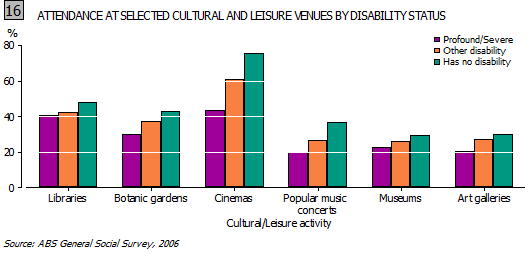 ATTENDANCE AT CULTURAL VENUES AND EVENTS
ATTENDANCE AT CULTURAL VENUES AND EVENTS
Apart from being rewarding for individuals, active engagement in cultural venues and events fosters varied and open social relationships and promotes social inclusion. It also contributes to community wellbeing by connecting people with others and in doing so, enhances quality of life.5
Cultural and leisure venues surveyed in the 2006 General Social Survey included visiting art galleries, museums, zoological parks and aquariums, botanic gardens, libraries, classical and popular music concerts, theatre and dance performances, musicals and operas, cinemas and other performing arts.
The two venues most likely to have been frequented in the 12 months prior to interview were libraries and cinemas, although having a disability and the severity of the disability decreased the likelihood of an individual attending these places. Cinema attendance was reported by 44% of people with profound or severe disability. For people with less restrictive disability, this rose to 61% and to 75% for people without a disability (see Graph 16).

In terms of disability group, there was not a great deal of variation in reported attendance at a cultural or leisure venue. Results ranged from 78% for people who reported a sensory disability, to 84% for those experiencing a psychological disability. However, looking at individual events, it becomes clear that the intellectually disabled are going to a smaller range of events, as their participation rates are lower than those from other disability groups for most venues. The exception appears to be attending the cinema and circuses.
Attendance at cultural activities varied across the different age groups, with activities such as zoos, wildlife parks and botanic gardens being most popular for the younger people with profound or severe disability, while libraries and cinemas remained popular destinations throughout all ages.
The sex of a person had no statistically significant impact on their likelihood of having attended a cultural or leisure activity in the 12 months prior to interview. In contrast, the severity of disability did have an impact, with 72% of people with profound or severe disability attending a venue, compared to 92% of people without disability.
Attendance patterns at the given venues were generally similar across geographic areas, except for remote Australia, where the participation rates were noticeably lower. Access to these venues would be an issue for many of the people from remote Australia though, regardless of their disability status.
 Print Page
Print Page
 Print All
Print All